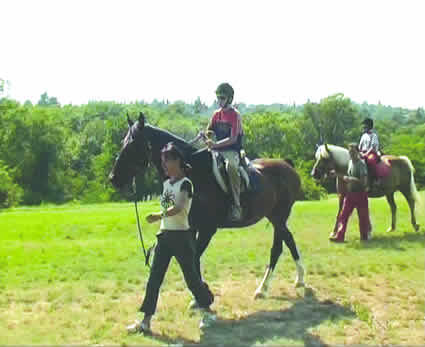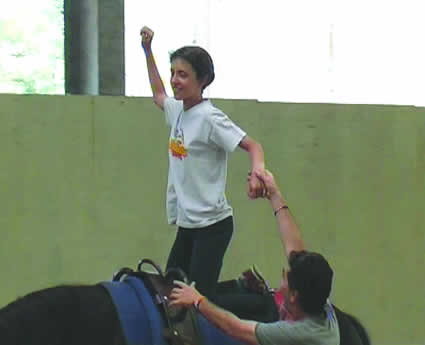Riding a Horse: A New Experience
By Irene Schiff
Everything began with a group of parents throwing ideas around.
"At first I was so curious, but at the same time I was a little scared
and so at the beginning I let my friends climb on their horses and I stayed
close to them, walking. Then, I wanted to try too, and at the end I didn't want
to climb down anymore." This is Giulio speaking, a friendly boy and one of the
four participants to the week of horse riding for girls and boys who are blind
or visually impaired. Four 11-year-olds full of vitality and curiosity, two boys
and two girls willing to experience new things, but, of course, also a little
scared. For most of them, it was their first experience, but after five days
they knew how to saddle, clean, lead their own horse either in a ring or for a
ride. Not only that, they even learned how to carry out small carousels and team
games, always under the affectionate supervision of their instructors.
Everything began with a group of parents throwing ideas around, ideas
immediately welcomed with much willingness by the Institute for the Blind
Francesco Cavazza and particularly its director Mario Barbuto. It
was organized, thanks to the Aiasport Association, in the wide and green
ring of San Lazzaro, Il parco dei cavalli-Gese. 
Twenty years ago, I began working in this
field when it would have been more credible to say you had just met an alien
rather than think that a person with a disability could practice horse riding! I
have seen so many boys and girls riding, but every time it is so moving to
see the fond and productive relationship that is created between differently
abled persons and a horse. Hippotherapy is a very ancient technique, even
discussed in the fourth century B.C., but only recently is it again back in
practice with much satisfaction. What is so special about a horse for Camilla,
Debora, Giulio and Matteo, our Amazons and cavaliers, that they have decided to
try it first for a week and then wanted to make it a weekly event for 2004-2005?
Let's ask them directly. "What I liked most?" says the affectionate Camilla "to
go for rides in trails going up because I could feel that the horse was strong,
but at the same time I was the one telling him where he was to go." "For me"
adds Matteo the chatterbox of the group "it was fun to
lie on his back and kneel on the saddle like an
"it was fun to
lie on his back and kneel on the saddle like an
athlete in a circus. We have also talked to the veterinarian, the artisan and
the man who takes care of the horses and we learned so many new things." What
about the more technical aspects? First we concentrated on ORIENTATION. In fact,
it was essential for the kids to have a good understanding of their
environment and to succeed in getting around in an independent way between
the stable, the harness room and the ring. We then went on to the SPORTING
ASPECT of it: getting close to the horse, getting on it, basic rules to ride it;
when on the saddle, get the horse to go ahead, have it turn in the desired
direction, stop it. It isn't all that simple. All of us, and particularly
persons who are blind, use the contact of our feet on the ground for
orientation, but sitting on a saddle on a horse, this is impossible to do.
It
is not possible either to touch walls or furniture, other usual sources of
information, because the hands are busy holding the reins. The awareness of
one's own position in space must therefore be absolutely clear. It is not easy
work even if blind or visually impaired persons have gotten used to it.
Our
cavaliers have also fabricated the model of a ring with the collaboration of the
whole team of instructors, lead by physiotherapist Claudio Bonazzi, but the
whole thing is their doing. To better give an idea of orientation, numerous aids
from the place were used: to recreate a sandy terrain, sand from the area itself
was used; to indicate the large oak tree where in its shade horses and cavaliers
rested or attented educational activities (for the latter, only cavaliers!),
pieces of bark and leaves were used from the same tree and these were gathered,
of course, by the children themselves. And the FUN part? With four participants
such as these, fun was certainly around! And Aramis, Cico, Linda and Margherita,
the four sensitive and patient chargers, what did they think? Translating into
words the grace of their movements, the calm with which they let themselves be
held, cleaned, riden, the pleasure they demonstrate when they crunched noisily
on the carrots the cavaliers gave them, it's hard to tell who from this
experience is more content, the horses or the cavaliers. In regards to SELF
ESTEEM, emotions and cognition fundamental to all, particularly those who are
differently abled, I believe that the best comment would be the one we have kept
for last by the proud and sweet Debora, the fourth participant in the group who
said, while she was busy taking the saddle off her horse: "I can go on a horse,
but my friends can't."